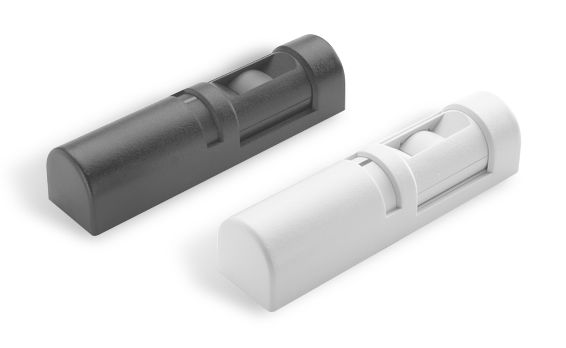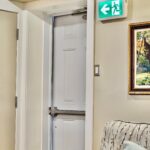 This is something that I don’t know a lot about, because it’s not really code-related. But I’m POSITIVE that some of you are experts and I hope that you will share your expertise in the reply box below. I say that it’s not code-related because although the model codes do require a sensor to be used with certain types of electrical locking systems, the codes are not specific about the type of sensor that must be used.
This is something that I don’t know a lot about, because it’s not really code-related. But I’m POSITIVE that some of you are experts and I hope that you will share your expertise in the reply box below. I say that it’s not code-related because although the model codes do require a sensor to be used with certain types of electrical locking systems, the codes are not specific about the type of sensor that must be used.
For access control systems where the lock is released by a sensor on the egress side (typically electromagnetic locks), the International Building Code (IBC) simply says: “The sensor shall be installed on the egress side, arranged to detect an occupant approaching the doors, and shall cause the electric locking system to unlock.” The type of technology used in the sensor is not addressed.
So I ask you…what’s the best/most reliable/most secure type of sensor to use as a request-to-exit sensor in an access control system? Passive infrared? Microwave? Temperature? Dual technology? Something else? If you have a preference, tell me why (please).
WWYD?
You need to login or register to bookmark/favorite this content.





I typically prefer a dual technology sensor (PIR and temperature). This is largely due to the fact that a PIR sensor on a perimeter door (think shear lock or storefront with mag locks) can be easily defeated by fishing something under the door on a coat hanger and waving it around.
Yes – that seems like a problem! Thanks Matt!
– Lori
In my experience, I have used them all. But as I said in my last post, there are two situations involved that influence the decision: 1) Is the lock actually released by the device? or 2) is only the alarm shunted by the device? In the case of the former both release and shunting by the RTE device would be required. This often leads to timing problems if you are using the bonding sensor of a mag lock to monitor the door (I use both a bonding sensor or LPS and a door position sensor to make this detection). The recognition of an unsecured condition must be delayed (not long… say 200Ms) so the RTE can sense an authorized entry (i.e. person approaching or opening the door from the inside)before the unsecured condition is detected.
Normally, I would use a motion detector (dual technology) if we are only shunting the alarm in a retrofit application. If the system is new, I typically use the RQE within a push bar or lever trim to shunt the alarm and/or release the mag lock. In this way, the attack vectors are at least equal to a standard push-pad panic device. Where a mag locks are involved, the door should release just like an exit device, but it does not; there is a minuscule delay (like .05Ms), but its a delay none the less.
Which is the best, depends on the specific situation; but generally, I stick with either switches mounted in the lock or panic device; or dual technology motion detectors. Other ways include photo beam or dual tech intrusion sensors, mat switches and even exit buttons. In one case I built a “dual tech” solution where the interior vestibule door had to be opened first followed by an RQE activation (yes i know the issues involved with this solution) within the vestibule. It worked well.
I also use latch position sensors coupled with a specific kind of adjustable magnetic switch. The “forbidden condition” is door open OR latch held back. Now this is really germane to preventing Held Open alarms as doors can often return to the closed position without actually being latched. This situation fires off a Forced Door alarm When the door is pulled open from the exterior (no RQE). I once reviewed a system that was giving 500 forced doors per day (yes per day). Needless to say, the alarms went unanswered… thus creating a liability for the institution.
Lori, I would be very interested if any of your subscribers to this site also use LPS or bonding sensors. Oddly, I have never seen an integrator that would provide this solution for the customer. Meanwhile, the customer thinks he as secured his building.
Go figure…
Thanks for so generously sharing your insight, Jim!
– Lori
Jim.
Great comments. I use bonding sensors often, all military or federal buildings such as courthouses, congressional buildings etc. Even on private businesses that perform Pentagon contracts they use them.
Thats Great Rich. Kudo’s. Mag locks have their issues, but I have always found them to be reliable when correctly designed. To get around the issues (including fire rated doors), I have specified BOTH a mag lock and an electrified panic device equipped with ELR. The ELR keeps the latchbolt on the exit device held back and relies on the mag lock to provide day to day security. Should the mag lock be come inoperative (leaving the door unlocked), the ELR is released allowing the door to be secured electromechanically. Cardholders wont know the difference and the building is secure. This process is automated to detect when the mag lock is no longer performing.
Sounds great; is great… but this is a $10,000 door. All this would be unnecessary if the lock itself would give you feedback to tell you its locked or unlocked status. Mag locks are the ONLY device that i know can do this reliably though a bonding sensor. Most access control systems report what a relay output SHOULD be, but not what it really is. Checking some doors i found one fail safe door that was unlocked. Called the console room and the operator confirmed it was showing locked. Problem was solved when we found a blown fuse that powered the lock. Mag locks would have detected that in 30 seconds.
Thats great. What do you do to prevent loss of power? Do the mag locks release upon fire alarm? What power supply do you use (make and series or model number)?
All fixed, I think!
– Lori
At the University, we used PIR (passive infrared) detectors to shunt the alarm on exterior doors to all buildings that were upgraded to card access. They have proven very reliable and trouble free. We always used exit devices with electric strikes or electric latch retraction. We did not use mag locks or any other device that would inhibit exit. We did NOT wire the REX (request to exit) detectors to unlock anything as the exit device would let you out anyway. Think of the scenario where some lone person in a secured building at night hears something and goes to investigate. If the detector unlocked the door when a person walked up to in on the inside, whatever was outside could get in, even if it were a bad guy. This is why we tried to never use anything that needed to be released electrically to get out.
Thanks Rich –
Yes – that is one of the hazards of the sensor-release systems.
– Lori
You are generally correct; but design can minimize this problem.
As you can see, I am rather passionate about this topic.
I was with you until you said electric strikes. Although I too use electric strikes, I use them about as frequently as mag locks. There is a place for electric strikes, but only under specific circumstances. Do you use latch position?
As a manufacturer of Infrared, Doppler Radar and Time-of-Flight Sensors and for the reason described is why we choose to manufacture an Active Infrared (AIR) sensor as it’s more reliable with a focused beam aimed around the door handle area and thus eliminates most false triggers by people passing by. Doppler radar works well too but doesn’t have the specific detection zone capability of the AIR sensors. The newest state of the art Time-of-Flight (TOF) sensors utilizing lasers are being utilized more and more in all types of applications and industry as it can be positioned for vertical and horizontal arrays. In essence, once ToF is understood it can be exploited in many ways. Additionally ToF sensors detection area can be defined by the inch or the person walking a given area. Additionally they are now becoming capable to utilize a 3-Dimensional detection field for detecting where a person is within the detection field, the size of the person, the height of a person or object is within the detection field. All in real time.
The problem described by Rich can be avoided with a panic style push bar (no locking hardware) or a push button REX.
Take a look at this.This is what a risk assessment technician found at our facility. He did it from the bottom of the door and was able to get in. We are looking into different options to correct this.
https://www.youtube.com/watch?v=xcA7iXSNmZE
Hi Doug –
I’ve seen this guy before…I’m sure the crooks have seen him too!
– Lori
We used to use the GE Security Interlogix RCR-REX-W Request To Exit Dual Tech Sensor, this has both passive infrared and Doppler range-controlled radar, but I believe they are [DISCONTINUED]